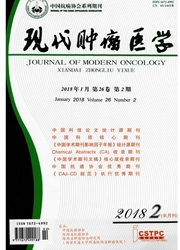

 中文摘要:
中文摘要:
目的:检测Twist1在乳头状甲状腺癌组织及细胞中的表达情况,并探讨其与乳头状甲状腺癌的临床病理因素和生物学行为的关系.方法:研究应用免疫组织化学方法检测120例乳头状甲状腺癌组织中Twist1的表达.体外细胞研究构建靶向Twist1的shRNA真核表达质粒,转染乳头状甲状腺癌细胞,采用MTT法检测细胞转染前后增殖能力变化,通过Boyden小室实验以穿过人工基底膜的细胞数量评估甲状腺癌细胞株体外侵袭能力的变化;同时检测细胞间连接及黏附相关蛋白E-cadherin、Vimentin等的表达情况.结果:免疫组化结果显示,Twist1在乳头状甲状腺癌中的表达水平与肿瘤的淋巴结转移呈正相关(P<0.05),与其他临床病理因素(如临床分期、分化程度等)没有明显相关性.RNA干扰使乳头状甲状腺癌细胞株IHH-4中Twist1的表达下调;与阴性对照组比较,Twist1蛋白表达分别降低了50%(KD-A)、60%(KD-B)和64%(KD-C).且E-cadherin表达上调,Vimentin表达下调.结论:Twist1在人乳头状甲状腺癌中表达上调,与肿瘤的淋巴结转移相关.针对Twist1的shRNA真核表达载体能明显抑制乳头状甲状腺癌细胞的Twist1表达,并有效抑制乳头状甲状腺癌细胞的体外侵袭能力.Twist1可能通过调控乳头状甲状腺癌的上皮-间质转化过程来影响其局部浸润及淋巴结转移.
 英文摘要:
英文摘要:
Objective:To detect the expression of Twist1 in papillary thyroid carcinoma(PTC),and explore its relationship with clinical pathological factors and biological behavior of PTC.Methods:Expression of Twist1 was detected by immunohistochemical in 120 cases of PTC.Short-hairpin(shRNA) eukaryotic expression against Twist1 were constructed,then transfected into PTC cells.Cell proliferation and invasion were evaluated by MTT assay and Boyden chamber experiment.Simultaneously,detected the expression of E-cadherin,Vimentin by Western blot.Results:Immunohistochemistry showed Twist1 expression level was positively correlated with lymph node metastasis(P 〈 0.05),there was no obvious correlation with other clinicopathological factors(such as clinical stage,differentiation,etc).The expression of Twist1 with RNA interference was reduced;compared with the negative control group,the expression of Twist1 protein were reduced by 50% (KD-A),60% (KD-B),64% (KD-C),and expression of E-cadherin was up,Vimentin was down.Conclusion:Twist1 upragulation in human papillary thyroid carcinoma was correlated with tumor lymph node metastasis.shRNA eukaryotic expression against Twist1 could significantly inhibit the expression of Twist1 in papillary thyroid cancer,effectively inhibit invasion and metastasis of thyroid papillary carcinoma in vitro.It indicates that Twist1 may influence localinfiltration and lymph node metastasis of papillary thyroid cancer through regulation EMT(epithelial-mesenchymal transition) process.
 同期刊论文项目
同期刊论文项目
 同项目期刊论文
同项目期刊论文
 期刊信息
期刊信息
